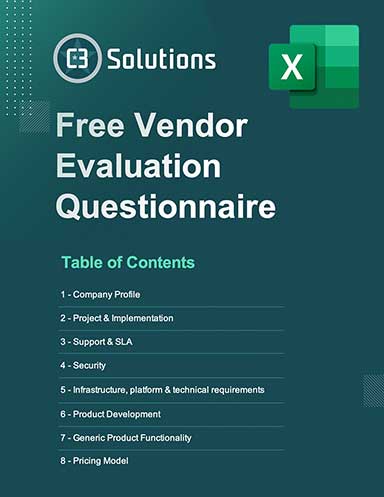Six emerging supply chain software trends to watch
As more companies work to make their global supply chains more resilient, strong, and efficient, supply chain management software continue to play an important role in those efforts.
Agroup of applications that come together to help organizations run their end-to-end supply chains, supply chain management software (“SCM”) is used to manage the flow of goods, data and finances across these critical networks.
A category that includes inventory management, procurement, order processing, demand forecasting, warehouse management (WMS) and transportation management (TMS), among others, SCM helps companies improve efficiencies, reduce costs, and maintain high customer service levels.
As with most supply chain-related components right now, SCM has become an imperative for a wider swath of companies in the post-pandemic world. Organizations that may have historically relied on spreadsheets, paper, pens, and phone calls to run various aspects of their supply chains, for example, are increasingly turning to technology for help in navigating the complexities of a persistent labor shortage, growth in e-commerce orders and customers that expect lightning-fast order delivery times.
“Given all of the disruptions that organizations have experienced over the course of the pandemic, we’re seeing a significant interest from companies that want to understand how they can become more responsive,” says Caleb Thomson, senior director, analyst supply chain strategy and planning at Gartner, Inc. “They also want to overcome some of the perceived ‘limitations’ within their own supply chain-related systems architecture.”
According to Thomson, those limitations include legacy type client-server software infrastructures and legacy middleware services (for sharing information between otherwise siloed systems). “Companies are thinking harder about the type of technology changes that will help them become more responsive—and quickly,” says Thomson.
Following are six more emerging SCM trends that supply chain technology experts are currently tracking.
1. Companies want software that drives decision alignment. Now that we’ve entered a more stabilized market environment—at least when compared to the height of the pandemic—Thomson says the focus has shifted to longer-term demand management and forecasting.
As they look to the future, companies know that they want (and need) better alignment across their global supply chains and the solutions that support those critical networks. Thomson says they also want those supply chain activities to be “coupled more tightly with financial planning.”
“Larger organizations, in particular, now have pretty good approaches in place to drive decision alignment and ensure access to quality data readily that can be used to support more efficient, effective supply chain decision-making,” says Thomson, who sees life science and high-tech/semiconductor manufacturing as two of the sectors that are making good strides in these areas. “That’s where I hear of the clearest need to have a very long-term strategy around production allocations,” he says.
2. High demand for risk evaluation software that companies can use to run simulations. More companies right now are evaluating the risk within their end-to-end supply chains and looking for software solutions that help them identify and mitigate that risk.
“Supply chains are moving faster and more resiliently right now, and companies are becoming even more focused on evaluating risk—both in terms of their supplier bases and their manufacturing/sourcing sites [i.e., those situated offshore],” says Michael McCullough, VP, NA supply chain lead at Capgemini.
For example, companies that previously had a heavy concentration of supply coming from China are exploring reshoring, onshoring and near-shoring opportunities. “I can’t think of one client we’ve worked with that hasn’t put together at least a secondary strategy tier for [their suppliers],” says McCullough. As that theme continues, companies will be looking for additional inventory management and other SCM tools “to be able to manage everything,” he adds.
For example, more vendors are now adding simulation capabilities in their applications, and especially on the planning side. These models can be used to simulate different scenarios and to test different strategies. In turn, says McCullough, can help companies make better decisions about their supply chains and answer risk-related questions like: “If we were to change suppliers or start sourcing from another country, just how quickly will we adapt to that shift and start benefitting from it?”
3. Generative AI: A game-changer for supply chain management. A type of artificial intelligence (AI) that creates new data and content (versus just analyzing existing data), generative AI has made a “huge splash in the marketplace” over the last eight months to 10 months, Thomson says. Along with producing simulation models, generative AI can also identify new inventory optimization opportunities, locate new sources of supply and create new transportation routes.
“We’re hearing about some interesting opportunities from technology service providers that are using generative AI/ChatGPT-like functions in their [solutions],” says Thomson. For example, interactive chatbots are being utilized to guide users in a help desk-like function, and generative AI is being used for data analysis and visualization. A company can use natural language-driven prompts to interpret its customers’ requests and align those requests with a specific data query. Those requests can then be further honed or refined using just natural language input. “These are just some of the emerging opportunities to leverage generative AI and SCM solutions,” says Thomson.
4. Putting microservices to work in supply chain management. Prior to joining St. Onge Co. as its director, supply chain systems, Howard Turner worked for a warehouse automation provider that billed its software as being “modular.” Over time, that term has morphed into what are now known as “microservices.” A software architectural approach that structures applications as collections of “loosely-coupled services,” microservices are made up of self-contained services that can perform a single function.
Look for more SCM application providers to take the microservices approach in the near future. “Microservices isn’t a new term, but we are fielding more requests from companies that want to know what it means and how it works,” says Turner. Because they let companies implement only the functionality that they actually need (e.g., pick modules with smart replenishment capabilities), microservices applications feature shorter deployment timelines.
“Microservices also reduce risk because those deployment timelines are shorter,” Turner says. “Companies can deploy the functionalities that work pretty well with their existing systems, as opposed to going through a full-blown WMS implementation.”
5. The cloud maintains its reign in the SCM space. The cloud has become a crucial backbone for many organizations. In fact, 94% of them are currently using cloud services—an adoption rate that drove up the value of the global cloud computing industry to a whopping $480.04 billion last year.
The SCM space hasn’t been immune to this transition from on-premises software and over to cloud-based options. “Cloud is becoming the preferred model for SCM applications,” says Turner. “The traditional approach of buying SCM software and licenses—and then installing the applications in your data center and waiting for software updates to be sent—is definitely going away.”
Instead, the software updates are now pushed out automatically, similar to what happens with consumer mobile phone updates. “IT organizations need to be prepared for that, and also need to understand the value proposition for the software itself,” says Turner. In other words, the long-term subscription fees associated with the cloud could over time wind up costing an organization more than they’d pay for a traditional on-premises application.
“Take the time to understand everything that the fees cover,” Turner recommends, “including your future upgrades plus any managed services for your servers and databases.”
6. Labor management systems as more than just employee monitoring tools. Historically, labor management systems (LMS) have been used to track employee time and attendance; manage schedules and payroll; comply with labor laws; and monitor work-force metrics like productivity, absenteeism and turnover.
Now, Norm Saenz, partner and managing director at St. Onge Co., is seeing companies put the software to even better use as an employee coaching, support and retention tool. The labor shortage is driving some of the shift, which is also happening because LMS has in the past been seen as more of a “big brother is watching” type of workforce management tool.
“Companies are concerned about the labor market. They want to treat their employees as fairly as possible, ensure those workers are being paid the right compensation and that they have the chance to provide proper feedback,” says Saenz, who sees more companies using their LMS less as tools for tracking incentive pay (i.e., doling out extra incentives to the highest performers) and more as coaching mechanisms for those workers.
For example, an LMS can give insights into individual performance and productivity. Then, that data can be used to coach and train workers, versus just deciding which of them do or don’t deserve incentive pay. “They’re using LMS as more of a coaching mechanism and to see how they’re doing, but not really paying them on incentives based on the data,” says Saenz, who recognizes that this isn’t necessarily what LMS were designed to handle.
“In most cases, companies install LMS in order to track their incentive-based pay programs,” says Saenz. “Now, they’re looking for systems that handle that while also accurately capturing all of the things that happen for a given job.”













